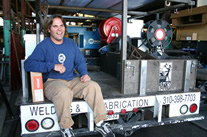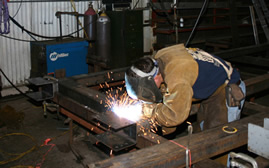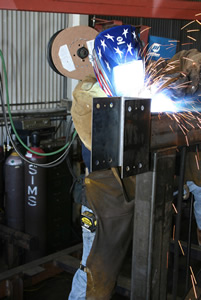Executive Summary
Banks Welding & Fabrication relies on welding equipment from Miller Electric Mfg. LLC and consumables from Hobart Brothers to increase productivity on structural and architectural steel designs.
Douglas Banks, owner, reports the following:
- Metal cored wires increase productivity by 30 percent.
- Metal cored wire permits multiple-pass welding without cleanup.
- Metal cored wires double deposition rates and provide good weld quality.
California Fabricator Increases Productivity By 30 Percent With Switch to Metal Cored Wire
 |
| Owner Doug Banks has been able to improve productivity by 30 percent since switching to metal cored wire. |
It can be difficult to be both “artistic” and “cost effective” in the high skill trade of metalworking. Just don’t tell that to Douglas Banks. As the owner of Banks Welding & Fabrication (headquartered in Inglewood, CA), he has built an empire of twisted steel and eccentric clientele through hard work and a keen business sense. Specializing in both structural and architectural steel design, Banks has spent the last 12 years perfecting his business: an intriguing mix of art and metal that is both eye-catching and structurally flawless.
But like anyone else in this industry, the cost of materials and labor is a constant concern for Douglas Banks. How does a business owner balance the need for impeccable craftsmanship and the desire to keep costs down? Banks found an answer to that question by switching its welding consumable from flux-cored wire to a gas-shielded metal cored wire—Hobart® FabCOR 86R from Hobart Brothers. Combined with welding equipment from Miller Electric Mfg. Co., the metal cored wire has provided numerous process efficiencies and has increased Banks’ production by more than 30 percent.
Extreme Custom Metalworking Gets Streamlined
Banks Welding & Fabrication serves both commercial and residential customers and takes particular pride in jobs that are “eccentric, artistic, difficult-to-build designs.” Whether it’s a private staircase, structural beams or extreme sports ramps for the X-Games, Douglas Banks tackles each job as both a businessman and as an artist.
Like most contractors/fabricators, Banks fabricates as much of an assembly as possible in the shop. Banks’ welding operators build most of their creations almost entirely of A36 mild steel with wall thicknesses ranging from 3/16-in. to 1-1/2-in. In the shop, they use Miller’s CP-302 MIG welding power source (300 amps at 32 volts, 100 percent duty cycle) matched with a 22A, 24-volt constant speed wire feeder, also from Miller.
 |
| Banks' welding operator Ray Amaya uses Hobart Brothers' FabCor 86R to weld a steel beam. |
In the field, the company uses Miller’s Trailblazer® 301G engine driven welder (300 amps at 25 volts, 100 percent duty cycle). Both systems provide the ideal rated duty cycles for Banks Welding as they create most of their welds at a setting of 32 volts with a wire feed speed at a constant 475 inches per minute (IPM).
Prior to 2002, the company used an AWS E71T-8 flux cored wire on all its projects. While this self-shielded wire performed well, Banks was looking for a way to further increase the pace of production. Local distributor Sims Welding Supply introduced him to FabCOR 86R, an AWS E70C-6M H4 gas-shielded metal cored wire. The difference was immediately noticeable.
In contrast to self-shielded flux cored wire, metal cored wire contains more iron powder in the flux, which helps increase deposition rates (the amount of wire burned, measured in pounds per hour), deposition efficiency (amount of wire used that goes directly into the weld) and faster travel speeds. But even more important to Banks’ production is the fact that the FabCOR 86R metal cored wire does not produce the slag associated with flux cored wires. As FabCOR also creates minimal spatter, it requires little or no post-weld cleanup.
 |
| Banks welding operator Ray Amaya can create quality welds, even in tight corners, with the FabCor 86R. |
The fact that Banks’ welding operators don’t have to spend time chipping slag or grinding after making each weld is a huge cost savings, considering almost all of the company’s jobs require multiple passes. With FabCOR 86R, the welding operators can keep laying bead after bead with minimal inter-pass cleanup.
“The good thing about FabCOR 86R,” says Banks, “is that we can run one pass and then another pass right over it. We don’t have any type of slag inclusions, which keeps the welds really clean.”
This multi-pass capability of the metal cored wire, matched with high deposition rates and faster travel speeds, is a major benefit for Banks’ operations.
“On a job where the metal is only 1/4-in. thick, we’d generally make one pass,” says Banks. “On 1-in. thick material, we can do five to ten passes. Even so, the welding operators can get a high deposition rate and take less time. With a self-shielded wire, you couldn’t do that.”
Using a .045-in. diameter FabCOR 86R metal cored wire, Banks achieves an average deposition rate of 13 to 17-lbs./hr. (32-34 V/475-640 IPM). With a .068-in. diameter E71T-8 wire flux cored wire, such as Banks previously used, deposition rates measure less than 11 lbs./hr, with an average rate of 6 to 9 lbs./hr being more common. Note that E71T-8 wire is designed to be an all-position wire with a faster-freezing puddle, so it will naturally have a lower deposition rate than FabCOR 86R, which is for the flat and horizontal positions only.
Banks matches the .045-in. FabCOR 86R wire with a 75/25 Argon/CO2 gas mixture, which helps create a smooth arc and gives the welding operators more control for those tough weld passes. The improved control reduces the amount of spatter and allows Banks’ welding operators to complete the job even quicker because they have minimal post-weld work.
Douglas Banks acknowledges that there is a higher upfront cost with the metal cored wire versus flux cored wire, but that the time savings makes it a profitable choice.
“The process of welding with metal cored wire is about 80 to 100 percent faster than with the flux cored,” says Banks. “The five to ten percent increase in cost for the wire [is trivial] compared to the 30 percent better overall productivity. The main thing is that the welders work longer and harder than before.”
Improved Weld Quality through Metal Cored Wires
In addition to issues of speed, metal cored wires like FabCOR 86R offer technical benefits that improve overall weld quality. All of Banks’s structural welds must meet AWS D1.1 requirements and even more stringent local restrictions due to the increased risk of seismic activity in southern California. The FabCOR 86R wire meets and exceeds all required impact values, and all welds undergo ultrasonic testing to assure quality.
The key to passing these tests is a strong, solid weld with proper penetration and no slag inclusions. Take into account that each welding operator needs to weld T-joints, butt welds, groove welds and full penetration welds so the need for an extremely versatile wire is clear.
The only limitation to the wire, according to Banks, is that it FabCOR 86R not designed for vertical-up or overhead welds. To remedy this problem, they roll the work piece into a flat position using an overhead crane, a job they feel is a small price to pay for a wire that is proving itself by passing test after test and dramatically improving productivity.
 |
|
Using Hobart Brothers Fabcor 86R for structural architectural welding and fabrication offers quality, high strength welds.
|
“We have great success creating x-ray welds with the FabCOR 86R wire,” claims Banks. “Add that to the fact that we weld faster, and you can see why we are so satisfied.”
Industry Still Learning Benefits of Metal Cored Wires
Although metal cored wire is not a new technology, many in the metalworking industry are still unfamiliar with its benefits and how it can improve their productivity. Welding schools today teach new welders how to perform AWS D 1.1 structural welds with a self-shielded flux cored wire. However, Douglas Banks trains each of his new welding operators on the benefits of metal cored wires like FabCOR 86R and says they immediately see the difference.
“We school them right away (on the metal cored wires),” says Banks, “and they love it. Life is much easier.” Metal cored wires run differently from self-shielded flux cored wires, so training is important to help operators adapt to a new technique.
Since switching to metal cored wire, Bank’s increased productivity by more than 30 percent and operators are happier and more productive than ever before. Whether it’s a moment frame, an I-beam or an ornate residential gateway, Douglas Banks knows that his eye for business and art both serve him well. And the cost savings and improved weld quality he’s seeing with FabCOR 86R wire appeals to both of those sensibilities.